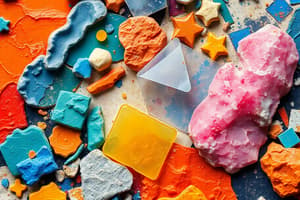Podcast
Questions and Answers
What is a characteristic of ceramic materials?
What is a characteristic of ceramic materials?
- They are primarily composed of metallic elements.
- They are always brittle in nature.
- They are composed of metal and non-metal elements bonded together by ionic and covalent bonds. (correct)
- They are typically amorphous in nature.
What is a milestone that expanded the utility and aesthetic appeal of ceramic products?
What is a milestone that expanded the utility and aesthetic appeal of ceramic products?
- Development of 3D printing
- Discovery of glazing techniques (correct)
- Development of advanced ceramic materials
- Invention of electric kilns
Which of the following ceramic materials is known for its high thermal resistance?
Which of the following ceramic materials is known for its high thermal resistance?
- Alumina (Al₂O₃)
- Zirconia (ZrO₂)
- Silicon carbide (SiC)
- All of the above (correct)
What type of bonds are characteristic of ionic ceramics?
What type of bonds are characteristic of ionic ceramics?
What is a common application of advanced ceramic materials?
What is a common application of advanced ceramic materials?
What is a fundamental aspect of understanding ceramic properties?
What is a fundamental aspect of understanding ceramic properties?
What is a characteristic of advanced ceramic materials?
What is a characteristic of advanced ceramic materials?
What is a common manufacturing process for ceramic materials?
What is a common manufacturing process for ceramic materials?
What is a type of ceramic material known for its high electrical conductivity?
What is a type of ceramic material known for its high electrical conductivity?
What is a traditional application of ceramic materials?
What is a traditional application of ceramic materials?
Flashcards are hidden until you start studying
Study Notes
Properties of Ceramics
- Ionic bonding gives ceramics high melting points and hardness.
- Covalent bonding in ceramics, such as silicon carbide, creates strong directional bonds, contributing to high stiffness and thermal stability.
Crystal Structure
- The crystal structure of ceramics heavily influences their properties.
- Ceramics can exhibit various crystalline structures, including cubic, hexagonal, and tetragonal.
- Zirconia can exist in multiple phases (monoclinic, tetragonal, and cubic), each with distinct properties.
Manufacturing Processes
- Ceramic manufacturing involves several key processes: raw material preparation, forming, drying, firing, and finishing.
- Each stage plays a critical role in determining the final properties of the ceramic product.
Raw Material Preparation
- The first step in ceramic manufacturing is the preparation of raw materials.
- Common raw materials include clays, feldspar, silica, and alumina.
- These materials are processed to remove impurities and achieve a fine particle size.
Forming
- Forming techniques include:
- Pressing: compacting ceramic powder in a mold under high pressure for dense, uniform products.
- Extrusion: creating long, continuous shapes with a constant cross-section.
- Slip Casting: creating complex shapes using a slurry of ceramic particles.
- Injection Molding: producing intricate and detailed shapes.
Drying
- Drying removes excess moisture from the ceramic material.
- Uneven drying can lead to warping, cracking, or other defects.
Firing
- Firing is the most critical stage in ceramic manufacturing, where the formed ceramic body is heated to high temperatures in a kiln.
- The firing temperature and duration depend on the type of ceramic material and the desired properties.
- Firing causes:
- Dehydration: removal of chemically bound water from the ceramic material.
- Phase Transformation: changes in the crystalline structure, affecting the material's properties.
- Densification: reduction of porosity and increase in density, leading to improved mechanical strength and durability.
Finishing
- Finishing processes include glazing, polishing, and machining.
- Glazing involves applying a glass-like coating to the ceramic surface.
Introduction to Ceramics
- Ceramics are non-metallic, inorganic materials that are typically crystalline in nature.
- They are composed of metal and non-metal elements bonded together by ionic and covalent bonds.
Historical Perspective
- The use of ceramics dates back thousands of years, with early human civilizations using clay to create pottery and tiles.
- The development of high-temperature kilns and the discovery of glazing techniques expanded the utility and aesthetic appeal of ceramic products.
Chemistry of Ceramics
- The chemistry of ceramics is fundamental to understanding their properties and manufacturing processes.
- Ceramics are primarily composed of oxides, carbides, nitrides, and borides.
- Common ceramic materials include alumina (Al₂O₃), zirconia (ZrO₂), silicon carbide (SiC), and silicon nitride (Si₃N₄).
Bonding in Ceramics
- Ceramic materials are characterized by strong ionic and covalent bonds.
- In ionic ceramics, such as alumina, there is a transfer of electrons from metal atoms to non-metal atoms, resulting in positive and negative ions.
Studying That Suits You
Use AI to generate personalized quizzes and flashcards to suit your learning preferences.




